If you’ve searched for anything on Google lately, chances are you’ve seen Google’s new AI overview feature. This update is causing quite a stir with users and marketers alike.
Initially launched as an experiment in May 2023 called Search Generative Experience (SGE), Google encouraged users to sign up and participate in the ŌĆ£new era of Search.ŌĆØ
Our team has compiled thoughts, insights, examples, and hypotheses to put together this Grit SEO Guide to AI Overviews. This will be a living document that we will update on an ongoing basis as new information becomes available and more data is aggregated and analyzed to understand the impact of AI Overviews.
What’s Covered in this Article
In this guide, our goal is to provide four things:
- Definition: What are AI Overviews?
- Impact: What results are we seeing and what industries are being impacted the most?
- Response: What to start, stop, and continue in your SEO strategy.
- Context: Connecting AI Overviews To The Bigger Picture.
Amidst change, our mantra here is that Growth Takes GritŌäó. Now is your chance to demonstrate some of that grit. Dig in and help your organization thrive in the new world of AI Overviews.
Definition: What are AI Overviews in Google Search?
AI Overviews in Google Search is an AI-generated summary of the answer to your query. It appears at the top of a Google search results page, above organic search results.
This Generative AI-powered summary aggregates information from web results to form a concise, informative answer. Google claims these overviews will do the work, so you donŌĆÖt have to, which is true for many of the queries weŌĆÖve seen AI Overviews appear in so far.
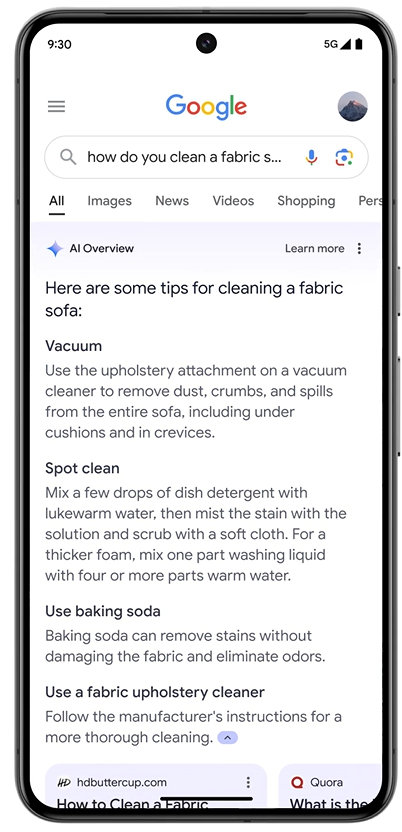
Powered by GoogleŌĆÖs Custom Gemini Model
AI overviews are powered by GoogleŌĆÖs Gemini model, which was trained to create simple AI-generated answers to complex questions.
Google announced, ŌĆ£This is all made possible by a new Gemini model customized for Google Search. It brings together GeminiŌĆÖs advanced capabilities ŌĆö including multi-step reasoning, planning and multimodality ŌĆö with our best-in-class Search systems.ŌĆØ
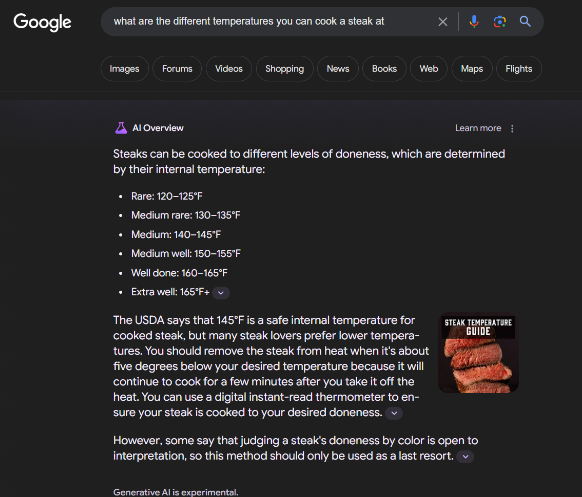
Source: Google search for ŌĆ£what are the different temperatures you can cook a steak atŌĆØ
Whether youŌĆÖre researching for a trip, planning recipes for the week, or wondering why your dishwasher isnŌĆÖt working, Google is simplifying your search experience by providing answers within an AI overview so you donŌĆÖt have to click through individual websites.
The way an AI Overview looks depends on the type of query. Here are a few examples of how it differs between commercial-intent and informational queries.
eCommerce AI Overview
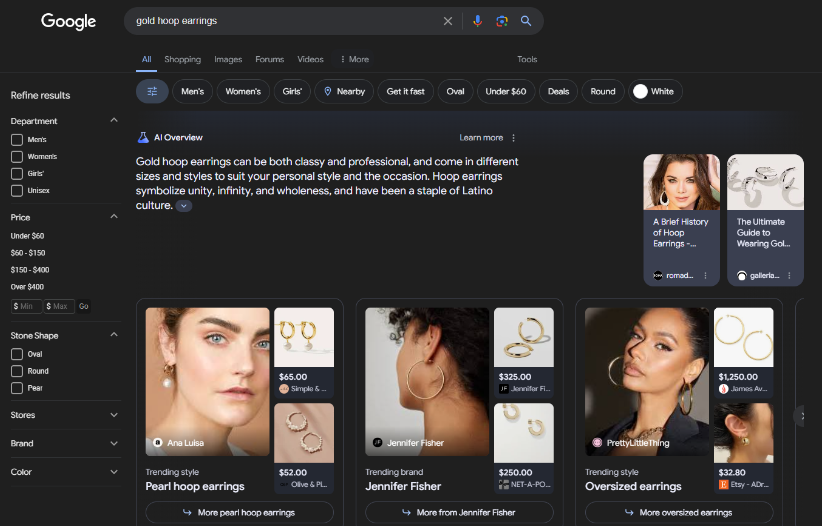
Source: Google Search for ŌĆ£gold hoop earringsŌĆØ
eCommerce overviews show a multi-faceted AI overview, including:
- A short summary of what gold hoop earrings are
- Links to informational content about gold hoop earrings, including the history of gold hoop earrings and a guide on how to wear them
- Types of gold hoop earrings, like pearl hoops and oversized hoops, with links to shop
- Featured brands with gold hoop earrings, like Jennifer Fisher, with links to shop
Even informational eCommerce queries include at least a few product links. For example, if you search for ŌĆ£what size TV is best for my living room,ŌĆØ the AI Overview starts with an informational list on how to choose the right-sized TV and includes a few recommended products.
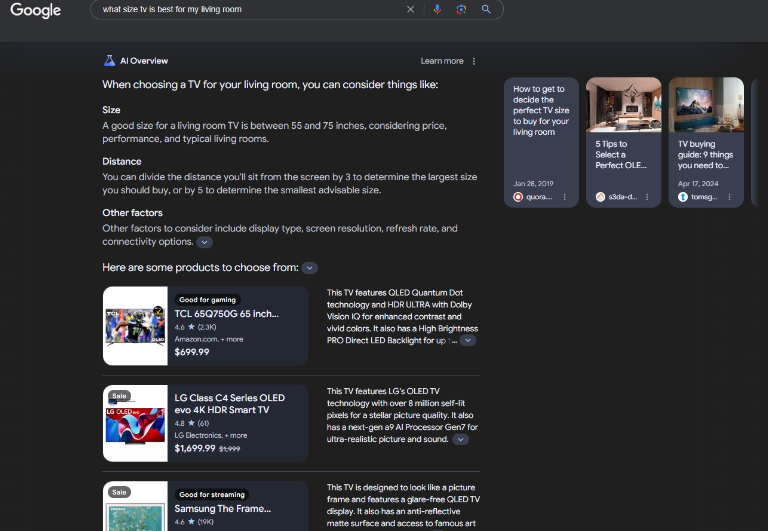
Source: Google Search for ŌĆ£what size tv is best for my living roomŌĆØ
You can expand the information or the number of products shown by clicking the down arrows.
Informational AI Overview
While some informational topics may always require in-depth research, AI Overviews can entirely replace others.
Take the AI Overview for the query, ŌĆ£Why does my candle burn unevenlyŌĆØ as an example. Expanding the AI Overview gives you a list of seven reasons your candle is burning unevenly, all of which you can troubleshoot without ever clicking through to one of the articles listed or scrolling further down to organic results.

Source: Google search for ŌĆ£why does my candle burn unevenlyŌĆØ
This has many publishers in an uproar, understandably so. If users can get everything they need from an AI Overview, whatŌĆÖs the point of having content on your website? Well for one, users could not get answers from GoogleŌĆÖs AI Overviews without Google being able to aggregate an answer from that content.
Early indications are that Google intends, to some degree, to provide credit where credit is due. In many AI Overview results you will notice links underneath the text are the sources for the AI Overview. Sometimes, the AI Overview re-writes text to be more concise ŌĆö as is the case with the candle query. Other times, itŌĆÖs taken word for word from publishers.
The screenshot below shows an AI Overview for ŌĆ£WhatŌĆÖs the best length necklace to wear.ŌĆØ The text underlined in yellow comes from the first linked source, VRAI, and the text underlined in red comes from the second source, Statement Collective.
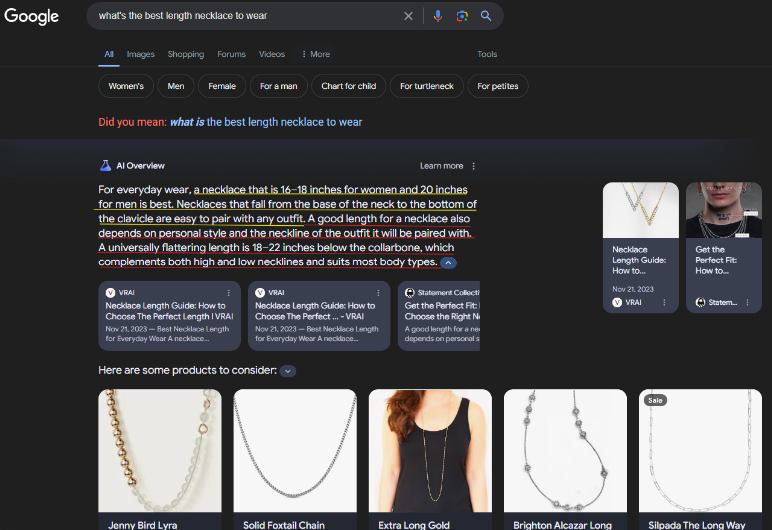
The text in the AI Overview is taken from each article almost word for word, with minor edits to shorten it. If you click on the links from the AI Overview, you are taken to that exact section of text within the article.
VRAI Text

Statement Collective Text

Upcoming Features for AI Overviews
What weŌĆÖre seeing now is only the first phase of AI Overviews. While Google hasnŌĆÖt announced release dates for all of the features below, most are slated as ŌĆ£coming soon.ŌĆØ
- Adjust the complexity of your AI Overview response. Soon, Google will launch two new AI Overview buttons: ŌĆ£simplerŌĆØ and ŌĆ£break it down.ŌĆØ This will allow you to see the answer to your query in simpler language ŌĆö as if youŌĆÖre trying to explain something to a child ŌĆö or go into more detail with the ŌĆ£break it downŌĆØ option.
- Ask complex questions. AI Overviews will be capable of answering complex questions thanks to the Gemini modelŌĆÖs multi-step reasoning capabilities. For example, you could search for something like, ŌĆ£find the best yoga studios near me with at least a 4.5 star average rating within a fifteen minute walking distanceŌĆØ and get a list of results meeting those criteria.
- Plan ahead. Google will help you plan for almost anything, though its capabilities are currently focused on vacations and meals in Search Labs (GoogleŌĆÖs testing environment). YouŌĆÖll be able to ask Google for things like ŌĆ£recipes for a keto-friendly 5-day meal plan,ŌĆØ ŌĆ£an itinerary for a 3-day trip to Boston,ŌĆØ or even ŌĆ£suggested workout routines.ŌĆØ
- AI-organized results page. Google will generate a search results page with AI-generated headlines, making it easier to browse different types of results, such as local businesses, user reviews, forum threads, social media videos, and informational articles. For example, Google might break down search results for ŌĆ£anniversary celebration dinner in DallasŌĆØ with headlines like ŌĆ£Anniversary-worthy restaurants,ŌĆØ ŌĆ£Romantic steakhouses,ŌĆØ ŌĆ£Historic charm and elegance,ŌĆØ and ŌĆ£Rooftop patios for dates.ŌĆØ
- Video search. Using Google Lens, youŌĆÖll soon be able to get help from GoogleŌĆÖs AI by taking a video of something and asking a question within that video. For example, you could take a video of a record player thatŌĆÖs not working and ask why the needle wonŌĆÖt stay in place. Google will respond with options to troubleshoot your exact device.

Where Does Google Get Data for AI Overviews?
Depending on the type of AI Overview, Google gets data from a variety of sources, including:
- HTML body content of webpages. A recent data study by Onely analyzed 140k SGE sources across 38 industries and found that 88% of text fragments featured in AI Overviews were pulled from a web pageŌĆÖs HTML body content (a technical way to refer text thatŌĆÖs visible on a page).
- Meta descriptions. The same study found that AI Overviews sometimes pull information from meta descriptions.
- GoogleŌĆÖs Shopping Graph. Product data in AI Overviews is pulled from GoogleŌĆÖs Shopping Graph, which is a machine learning-powered data set that utilizes information from Google Merchant Center, retailer websites, and third-party data from the web.
Further data analysis is needed to determine how frequently Google pulls data from specific sources across verticals.
Does Content in AI Overviews Only Come from Top-Ranking Pages?
No, content in AI Overviews does not only come from top-ranking pages. Understanding how and why Google pulls specific sites into AI Overviews is still a big challenge for everyone in the industry.
AI Overviews appear to use a different set of ranking factors than regular organic search results. The exact ranking factors used for AI Overviews arenŌĆÖt clear yet. With such a new rollout, Google is constantly adapting which sites show up in AI Overviews, changing as often as multiple times per day.
While much of the text featured in AI Overviews is pulled directly from web pages, this doesnŌĆÖt always mean the page ranks well in traditional organic search.
An eCommerce analysis from Onely found that 43% of SGE sources were not ranking in ŌĆ£old GoogleŌĆØ for the given query. This means that, even if you rank in the top ten positions, your content may not be featured in AI Overviews. It also means you donŌĆÖt have to rank on the first page to appear in AI Overviews.
How Google determines which websites to cite and generate AI Overview answers from will clearly be a huge interest for all brands and site owners going forward. As with all changes from Google, we will learn, adapt, and deploy strategies to win in this new world.
Impact: What We Are Seeing So Far for AI Overviews
How Many Queries Do AI Overviews Show Up For?
Google will not share data about the percentage of queries that generate an AI Overview. However, they donŌĆÖt appear for every query.
ŌĆ£AI Overviews are reserved to answer more complex questions where Google feels it can add value beyond the search results,ŌĆØ said Hema Budaraju, the Senior Director of Product for Search Generative Experience at Google.
While Google refused to share specifics on the percentage of queries that now have AI Overviews, a recent analysis of 100,000 keywords by SERanking showed only 8.71% of them have AI Overviews.
The SEO community conducted numerous data studies on the prevalence of AI search results since GoogleŌĆÖs SGE testing started in May 2023:
- A recent BrightEdge study found that Google showed fewer AI Overviews for search results than when testing started. Google search results without AI overviews increased from 25% to 65%.
- Similarly, a study from Onely shows the number of queries without AI Overviews jumped from 9% to 58% between February 2024 and May 2024.
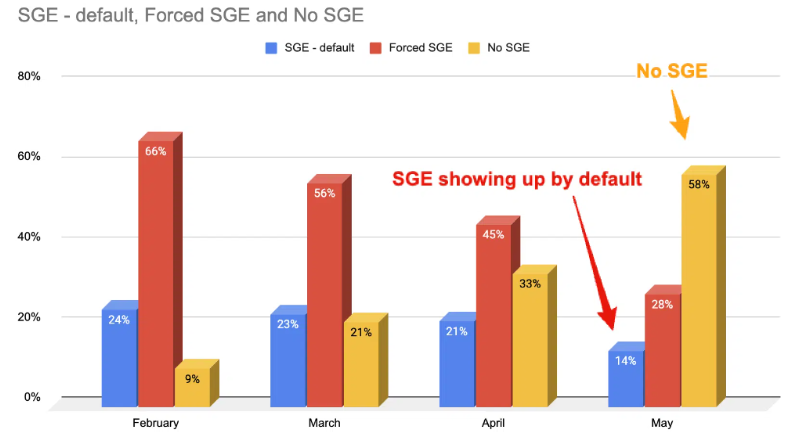
Analyzing AI OverviewŌĆÖs Impact on Organic Search Traffic
Analyzing website traffic from AI Overviews wonŌĆÖt be an easy task.
Hema stated in an interview that Google will start reporting on impressions and clicks from AI Overviews in Google Search Console. Still, they will not differentiate between what came from traditional organic search and AI Overviews.
Google claims that link cards within AI Overviews generate a higher click-through rate than traditional web search results. However, there isnŌĆÖt any data to back up this claim, and it wonŌĆÖt be easy for website owners to prove (or disprove) that.
In a recent interview, Google CEO Sundar Pichai maintained an optimistic, yet slightly cryptic, view on how AI Overviews will impact organic search traffic and click-through rates.
ŌĆ£I look at our journey, even the last year through the Search Generative Experience, and I constantly found us prioritizing approaches that would send more traffic while meeting user expectations,ŌĆØ he said. ŌĆ£…whatŌĆÖs positively surprising us is that people engage more, leading to more growth over time for high-quality content.ŌĆØ
He also claimed that some of GoogleŌĆÖs changes over the last decade focused on sending more traffic to smaller sites, and, in general, these recent changes are driving more traffic to the overall ŌĆ£ecosystemŌĆØ of Google search results.
What website owners need to know is that despite Google’s positive outlook on how AI Overviews may affect website traffic, there is a lack of data to back it up.
We suggest keeping an eye on overall traffic trends for specific keywords and manually checking what AI Overviews for your siteŌĆÖs top queries (or queries you want to go after) look like.
Users ArenŌĆÖt Big Fans of AI Overviews
Since the launch of AI Overviews, the internet has been flooded with requests for how to turn this feature off.
While this may seem like a positive sign for the ŌĆ£traditionalŌĆØ blue links (maybe users who dislike AI Overviews will scroll past it and continue clicking on publisher sites), it could also force users to stop using Google search altogether.
Searches for ŌĆ£how to turn off Google AIŌĆØ spiked the day it launched. Unfortunately, there isnŌĆÖt a way for users to turn off AI Overviews. At least not yet.
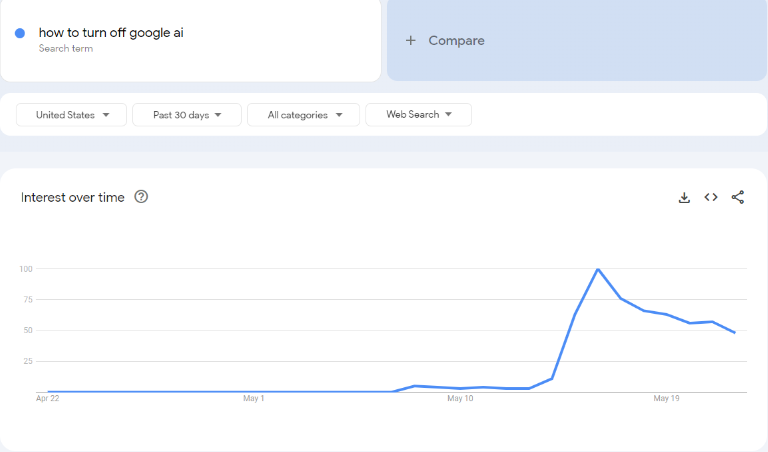
Source: Google Trends
Industries Where AI Overviews Are Most Prevalent
Early data from SEMrush shows that AI Overviews appear for only 0.48% of desktop and 0.57% of mobile search results.
As a caveat, rank-tracking tools havenŌĆÖt entirely caught up with this new technology yet. Rank trackers pull data from a logged-out browser, so this data may differ from what a logged-in user sees in AI Overviews.
Based on this analysis, verticals seeing the highest percentage of AI Overviews include:
- Health
- People & Society
- Science
- Internet & Telecom
- Pets & Animals
Google isnŌĆÖt straying away from AI Overviews for sensitive Your Money Your Life (YMYL) topics. This is mildly concerning, given Generative AIŌĆÖs potential to produce inaccurate and biased content.
GoogleŌĆÖs AI Overviews include a disclaimer at the bottom (if you expand the result) advising users to consult a professional for medical advice or diagnosis. However, many users may not expand the overview far enough to see this disclaimer or the sources feeding into the AI Overview.
Non-expanded AI Overview
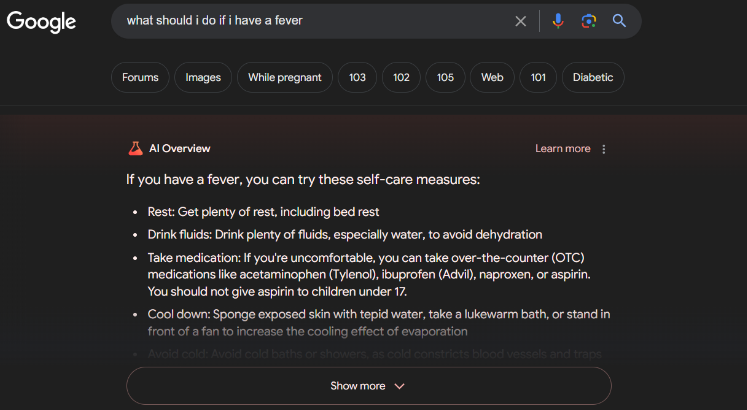
Source: Google search for ŌĆ£what should I do if I have a feverŌĆØ
Expanded AI Overview
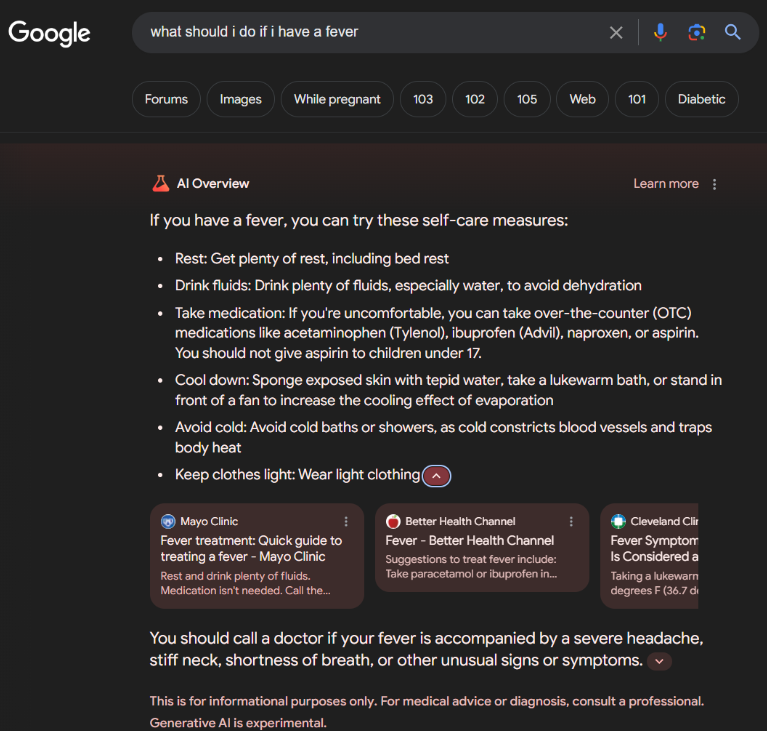
Source: Google search for ŌĆ£what should I do if I have a feverŌĆØ
Response: What To Start, Stop, and Continue in Light of AI Overviews?
When change happens, itŌĆÖs up to individual contributors to determine how theyŌĆÖre going to react. Will you just wait and see what happens? Or will you be one of the first to adapt? Are you excited to test new theories and see what works?
As the way people search for information on the internet continues to evolve, so will organizations.
We asked all of our Grit team members what they feel website owners should start doing, keep doing, and stop doing.
In general, our advice remains the same as it would for regular SEO: focus on content that is most relevant to your brand, provide the most helpful information possible, and ensure your brand is optimized across all Google Products.
What to Start Doing
Pivot Content Strategy
AI Overviews are going to replace a lot of top-funnel searches, like:
- How to
- What is
- Why is
Niche, in-depth content faces a lower threat of getting replaced by AI Overviews. For example, a topic like, ŌĆ£Highly Effective Marketing Strategies That Worked for My BusinessŌĆØ is stronger than ŌĆ£What is a Marketing Strategy?ŌĆØ
Take the time to really think about your content strategy and the topics youŌĆÖre going after. Ask yourself the following questions:
- Can this topic be answered with a simple AI-generated response?
- Are there ways to go deeper on this topic by including personal experiences, creating a round-up of expert opinions or reviews, or adding in some human element that users will find valuable?
- Are there ways you can connect with your audience using your brand voice? Emphasize any differentiators or proprietary brand elements you can, working them into content throughout the website.
- Can you make proprietary brand elements shine through a unique editorial angle on this topic?
AI Overviews still rely on the body content of actual web pages to generate answers, at least for now. A recent study found that, on average, AI Overviews use five websites as a source to generate text.
While we donŌĆÖt believe AI Overview sources follow traditional ranking factors of organic search, having optimized, well-informed, informational content on your website can help you appear in these new Overviews.
We also suggest:
- Testing levels of author expertise. Try testing an author with personal experience versus professional experience with hard credentials to back it up.
- Avoid content fluff and get straight to the answers. Organize your content in a clear question-and-answer format. Provide answers in complete sentences, restating the question.
- Make articles FAQ-focused. Instead of including an ŌĆ£FAQŌĆØ section as an afterthought at the end of an article, make the entire article this format.
- Publish original data studies. Publish any original data studies, customer insights, or first-party data you have. This adds a unique spin specific to your brand.
Own Your Brand in Every Google Product
SEO already reaches far beyond your website’s content and technical performance. While this isnŌĆÖt a recent development, itŌĆÖs even more critical for your brand and online listings to be optimized anywhere they appear in Google products.
Make sure your brand is fully optimized on every Google product thatŌĆÖs applicable, such as:
- Google Merchant Center. Optimize your product feed and ensure itŌĆÖs accurate and free from warnings or issues that cause disapproved items. This is one of the primary data sources of product listings in AI Overviews.
- Google Business Profile. Ensure all of your Google Business Profiles are fully filled out and optimized, including listing all of your services, responding to every customer review, uploading original imagery, and making Google Posts to highlight services, reviews, or special offers.
Own multimedia content, including:
- Images. Include as much original imagery as possible on your website and online business profiles.
- Videos. Get creative with video content, whether itŌĆÖs short-form content for social media or long-form informational YouTube videos.
- Social media posts. Google is more frequently featuring social media posts in search engine results.
Get Real User Feedback
Any way you can make your content unique and valuable to users will be a win. Look for ways to incorporate real user feedback, such as running surveys or creating focus groups.
Depending on your business niche, you may have to get creative here. However, real-life expertise and user feedback are huge value adds to content.
What to Keep Doing
You may have already done all of the above. If so, great job staying on top of SEO! Here are a few things we suggest you keep doing:
- Specifying authors and expert reviewers on each article
- Creating pages targeting specific long-tail queries
- Using schema
- Making sure Google can properly find, crawl, and index your site
- Writing what makes sense for your business niche
- Optimizing meta titles and meta descriptions
- Refresh informational content on your website, writing it in clear question and answer format
- Creating a plan for content that doesnŌĆÖt perform well (this is dependent on site traffic, but typically any page with less than 20 clicks in the last 6 or 12 months is a strong candidate for removing or optimizing)
- Creating content in every medium possible. Enhance content with original infographics, imagery, or videos, which all have the chance to appear in AI Overviews
What to Stop Doing
While we donŌĆÖt know exactly how AI Overviews will impact organic traffic, we suggest avoiding creating content on topics that can easily be answered in an AI Overview.
Topics like:
- What is [x thing]?
- How to [do something simple]
This will likely turn into zero-click searches. Why would someone click through to a website when the AI Overview gives them everything they need to know?
ThatŌĆÖs not to say you canŌĆÖt cover anything like this on your website at all, it just shouldnŌĆÖt be the sole focus of an article.
Context: Connecting AI Overviews To The Bigger Picture
While understanding and responding to AI Overviews is important, we wanted to conclude this article by zooming out and cracking the door to explore what this rollout connects to in the broader context of how commerce, content, media, and marketing as a whole are shifting in 2024 and beyond.
This will be a topic we will expand upon in the coming weeks with GritŌĆÖs thinking and guidance on how to perform in the now, while also preparing for the future.
While you potentially read this article because you are interested in SEO, we trust that the best SEOs in the world will outperform others by looking at SEO in the context of the marketing ecosystem as a whole. Be on the lookout for an article from us soon, but in the meantime, here are some thought provoking resources to help you expand your own thinking on the topic:
- The Next Normal by McKinsey
- People vs Algorithms: AI Time Machine Podcast
- United States of Amazon: Multiplayer Commerce
In This New Era of SEO, Growth Takes Grit
While technology disruptions can feel threatening, seeing a whole new industry blossom is also exciting. Google has indeed ushered in a new era of search, whether the world was ready for it or not.
If youŌĆÖd like support in navigating this change and positioning your organization for success in the ever changing world of SEO, weŌĆÖd love to chat. While technology and innovations can be complex to break down, our view on how to deliver consistently positive results is actually pretty simple. We call it our Growth Takes GritŌäó Formula for predictable success.
Thanks for tuning in and as a reminder, we will be updating this document on an ongoing basis to stay on the leading edge with the latest insights on AI Overviews.
